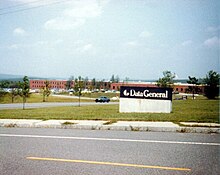
Back داتا جنرال Arabic Data General Catalan Data General German Data General Spanish Data General Finnish データゼネラル Japanese 데이터 제너럴 Korean Data General Russian Data General Swedish Data General Ukrainian
 Headquarters in Westboro, Massachusetts, 1981 | |
| Industry | Computer |
|---|---|
| Founded | 1968 |
| Defunct | 1999 |
| Fate | Acquired |
| Successor | EMC Corporation |
| Headquarters | Westborough, Massachusetts |
| Products | Minicomputers, disk arrays |
Data General Corporation was one of the first minicomputer firms of the late 1960s.[1] Three of the four founders were former employees of Digital Equipment Corporation (DEC).
Their first product, 1969's Data General Nova, was a 16-bit minicomputer intended to both outperform and cost less than the equivalent from DEC, the 12-bit PDP-8. A basic Nova system cost two-thirds or less than a similar PDP-8 while running faster, offering easy expandability, being significantly smaller, and proving more reliable in the field. Combined with Data General RDOS (DG/RDOS) and programming languages like Data General Business Basic, Novas provided a multi-user platform far ahead of many contemporary systems. A series of updated Nova machines were released through the early 1970s that kept the Nova line at the front of the 16-bit mini world.
The Nova was followed by the Eclipse series which offered much larger memory capacity while still being able to run Nova code without modification. The Eclipse launch was marred by production problems and it was some time before it was a reliable replacement for the tens of thousands of Novas in the market. As the mini world moved from 16-bit to 32, DG introduced the Data General Eclipse MV/8000, whose development was extensively documented in the popular book, The Soul of a New Machine. Although DG's computers were successful, the introduction of the IBM PC in 1981 marked the beginning of the end for minicomputers, and by the end of the decade, the entire market had largely disappeared. The introduction of the Data General/One in 1984 did nothing to stop the erosion.
In a major business pivot, in 1989 DG released the AViiON series of scalable Unix systems which spanned from desktop workstations to departmental servers. This scalability was managed through the use of NUMA, allowing a number of commodity processors to work together in a single system. Following AViiON was the CLARiiON series of network-attached storage systems which became a major product line in the later 1990s. This led to a purchase by EMC, the major vendor in the storage space at that time. EMC shut down all of DG's lines except for CLARiiON, which continued sales until 2012.
- ^ Klein, Stanley (October 2, 1977). "The Maxigrowth of Minicomputers". The New York Times.
© MMXXIII Rich X Search. We shall prevail. All rights reserved. Rich X Search